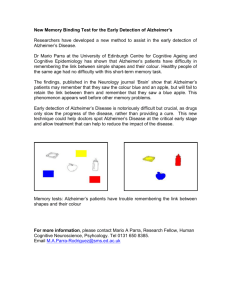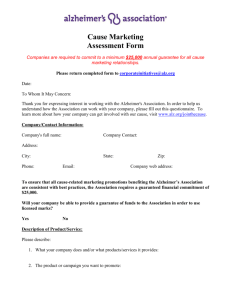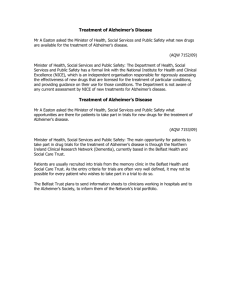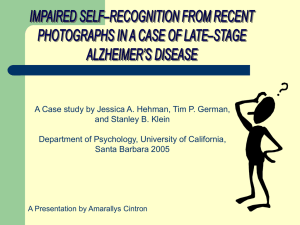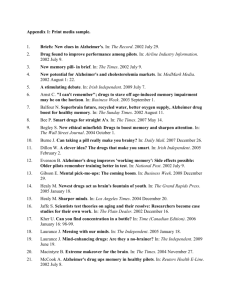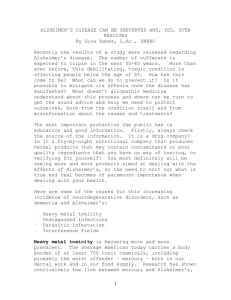Document 10772624
advertisement
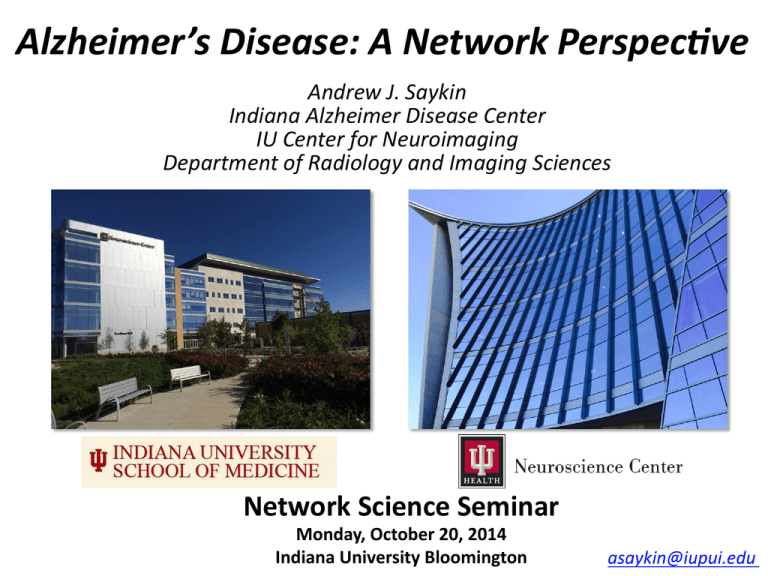
Alzheimer’s Disease: A Network Perspec7ve Andrew J. Saykin Indiana Alzheimer Disease Center IU Center for Neuroimaging Department of Radiology and Imaging Sciences Network Science Seminar Monday, October 20, 2014 Indiana University Bloomington asaykin@iupui.edu Disclosures & Acknowledgements • Na@onal Ins@tute on Aging – ADNI: U01 AG024904 & RC2 AG036535 – Indiana: R01 AG19771, P30 AG10133 (IADC) – U01 AG032984, U24 AG21886, P30 AG010129, K01 AG030514 • Ins@tute of Biomedical Imaging and Bioengineering • Na@onal Library of Medicine: R01 LM011360 and K99/R00 LM011384 • Na@onal Science Founda@on: IIS-­‐1117335 • Founda@on for the NIH (ADNI-­‐1 GWAS) – Anonymous Founda@on (Challenge Grant) – Gene Network Sciences, Merck, Pfizer (DNA extrac@on) • Alzheimer’s Associa@on & Brin Wojcicki Founda@on – Whole Genome Sequencing of ADNI-­‐GO/2 • Disclosures: – Siemens Healthcare, Eli Lilly, Avid, Pfizer, Arkley BioTek Alzheimer's Disease: Network Perspec@ves • Alzheimer’s Disease – A complex disorder: Snapshot of the science – Prodromal stages: Subjec@ve Cogni@ve Decline & Mild Cogni@ve Impairment • • • • Brain Networks – The Connectome Biomarker Networks (phenotype clusters) Gene Pathways, Networks & Systems Biology Social Networks – Families, Communi@es, Healthcare systems, Provider networks, Social media, Science of Science, ELSI issues ALOIS ALZHEIMER (1864-­‐1915) • German scien@st, ini@ally a professor of Psychology in Breslau. Later in Munich he worked on histopathology. With Franz Nissl, worked to establish the neuropathological basis of mental illness. Alzheimer published on cerebral arteriosclerosis in 1904 and Hun@ngton’s chorea in 1911. In 1907 he published the pathology of AD. Senile plaque (silver stain) Louis D. Boshes, M.D. Archives (UIC) The Memory, Aging & Alzheimer’s Puzzle Disease mechanism, Earlier detec7on, Personalized therapeu7cs Subjec@ve Cogni@ve Decline Informant Percep@on Cogni@ve Performance Lifestyle & environment -­‐ CogniKve sKmulaKon, diet, exercise, sleep, social networks Vascular func@on & disease Biomarkers -­‐ CSF, blood, others Genomics -­‐ DNA -­‐ RNA -­‐ EpigeneKcs Amyloid PET/CSF Tau PET/CSF MRI -­‐ structure MRI -­‐ func@on Connectome Therapeu@cs & Preven@on Immune System, Inflamma@on & Oxida@ve Stress Saykin 2014 Neuropathology, Plaques, Tangles & Abnormal Proteins (Disease Trigger is Still Unresolved) Amyloid Beta Protein Tau Protein Cummings & Cole, JAMA May 18, 2002, 2335-8 PSEN2 Major AD Genes: EOAD & LOAD LOAD: geneKc factors account for ~60-­‐80% of risk (Gatz et al 2006); APOE accounts for up to 50% (Ashford & MorKmer 2002); so up to 30% remains to be found. PSEN1 APOE Chromosome 19 APP 21q21.3 Chromosome 1 Chromosome 14 Chromosome 21 The DIAN ConsorKum Evidence that AD begins 20 years prior to diagnosis Bateman et al, NEJM (2012) Role of Biomarkers Temporal ordering and Kme-­‐dependent roles Pre-­‐MCI SCD h`p://adni.loni.usc.edu/study-­‐design/background-­‐raKonale/ Neuroimaging Phenotypes Subjec@ve Cogni@ve Decline Informant Percep@on Cogni@ve Performance Lifestyle & environment -­‐ CogniKve sKmulaKon, diet, exercise, sleep MRI -­‐ structure MRI -­‐ func@on Connectome Vascular func@on & disease Biomarkers -­‐ CSF, blood, others Genomics -­‐ DNA -­‐ RNA -­‐ EpigeneKcs Amyloid PET/CSF Tau PET/CSF Therapeu@cs & Preven@on Immune System, Inflamma@on & Oxida@ve Stress Saykin 2014 Imaging Biomarkers and Phenotypes: Structural Changes Hippocampus Cortical Atrophy White Matter: Connectome Voxel-­‐Based Morphometry (VBM) Earlier Detec@on than MCI? “Pre-­‐MCI” Imaging & Clinical Status Baseline Hippocampal Gray Mamer Density in MCI & Cogni@ve Complaints Right Hippocampal GM Density 0.68 0.68 0.66 0.66 * * 0.64 0.62 0.64 * * 0.62 0.60 0.60 HC N=40,40,40 Gray Matter Density Gray Matter Density Left Hippocampal GM Density CC MCI HC CC MCI * MCI < HC, p <.001 * CC < HC, p <.005 Saykin et al, NEUROLOGY 2006;67:834-­‐842 Altered Structural Connec@vity Pre-­‐MCI Connec@vity (Res@ng State fMRI) Decreased Right Hippocampal Connec@vity in Cogni@ve Complaint Group Wang et al JAD 2013 Multimodal Imaging in ADNI-2 Courtesy of M. Weiner, WW-­‐ADNI, July 2014 Alzheimer's Disease: Network Perspec@ves • Alzheimer’s Disease – A complex disorder: Snapshot of the science – Prodromal stages: Subjec@ve Cogni@ve Decline & Mild Cogni@ve Impairment • • • • Brain Networks – The Connectome Biomarker Networks (phenotype clusters) Gene Pathways, Networks & Systems Biology Social Networks – Families, Communi@es, Healthcare systems, Provider networks, Social media, Science of Science, ELSI issues The AD Phenome: Phenotype Profiling Project Saykin & Risacher, Unpublished data, 2014 The AD Phenome: Phenotype Profiling Project Saykin & Risacher, Unpublished data, 2014 Alzheimer's Disease: Network Perspec@ves • Alzheimer’s Disease – A complex disorder: Snapshot of the science – Prodromal stages: Subjec@ve Cogni@ve Decline & Mild Cogni@ve Impairment • • • • Brain Networks – The Connectome Biomarker Networks (phenotype clusters) Gene Pathways, Networks & Systems Biology Social Networks – Families, Communi@es, Healthcare systems, Provider networks, Social media, Science of Science, ELSI issues Systems Biology & The Diseasome Network Medicine — From Obesity to the “Diseasome” Albert-­‐László Barabási NEJM; 357(4) July 26, 2007 www.nejm.406 org Complex Networks of Direct Relevance to Network Medicine IGAP Meta-­‐Analysis: Now a “ Top 20” AD Genes (2013) Lambert et al Nature Gene@cs (2013)* Largest AD GWAS “In addi@on to the APOE locus, 14 genomic regions had associa@ons that reached genome-­‐wide significance. 9 had been previously iden@fied by GWAS as gene@c suscep@bility factors, and 5 (HLA-­‐DRB5–HLA-­‐DRB1, PTK2B, SORL1, SLC24A4-­‐RIN3 and DSG2) represent newly associated loci.” * ADNI data included as part of the ADGC Genomic Landscape of Associa@on Studies Sequencing or Imputed GWAS Manolio, Collins et al, Nature (2009); adapted from McCarthy et al, Nature Reviews Gene7cs (2008) Key molecules in AlzPathway Ogishima et al, Clin Pharmacol Ther, 2013; 93(5) Network enrichment meta-­‐analysis using ADNI data Glutamate Signaling Perez-­‐Palma et al, OverrepresentaKon of glutamate signaling in Alzheimer's disease: network-­‐based pathway enrichment using meta-­‐analysis of genome-­‐wide associaKon studies. PLoS One, 2014; 9(4). “Crosstalk” of dysfunc@onal pathways for AD brain regions • A: Gene sets from KEGG (AD & neighbor pathways) • B: PPI networks from 5 databases • C: Clustering PPI networks by 6 AD brain regions • D: Ranked pathways by dysfunc@on score based on ac@va@on during AD progression (apoptosis, notch & wnt signaling, cytokine interac@ons, etc) Liu et al (2010) BMC Systems Biology, 4(S2) hmp://www.biomedcentral.com/1752-­‐0509/4?issue=S2/S11 Aβ, Network Instability & Therapeutic Strategies Huang & Mucke, Cell, 2012:148(6) Drug Development Networks Alzheimer's Pathways and Therapeutic Targets (Existing FDAApproved Agents) Ogishima et al, Clin Pharmacol Ther, 2013; 93(5) Imaging Genetics: Relating Imaging, Genes & Clinical Information is a BIG DATA Challenge Gene“Chip” - Multiple testing problem - Non-independence due to LD and spatial autocorrelation Brain-­‐Genome Associa@on Strategies Candidate Gene/SNP ROI Circuit Whole Brain Saykin, 2011 Biological Pathway Risacher et al 2010 Egan et al 2001 COMT 0 2 ε4 1 AD Reiman et al PNAS 2009; Also Ho et al 2010 FTO Sloan et al 2010 Swaminathan et al 2010 PiB ROIs & amyloid pathway Reiman et al 2008 cholesterol pathway genes Genome-wide Analysis Potkin et al 2009; Saykin et al 2010 Potkin et al 2009 Mol Psych schizophrenia study Shen et al 2010 ROIs; Stein et al 2010 voxels Connectome as GWAS Phenotype: SPON1 Gene chromosome 11 (11p15.2) Altered Brain Networks in AD: Disordered Connectome and Connec@vity Jacobs et al, Meta-­‐analysis of func7onal network altera7ons in Alzheimer's disease: toward a network biomarker. Neurosci Biobehav Rev, 2013. 37(5):753-­‐65. Meta-­‐Analysis: Altered Default Mode Network and Task-­‐Based Networks Fig. 2. Mul@modal meta-­‐analysis of default mode network connec@vity and task-­‐related ac@va@on in mild cogni@ve impairment pa@ents. The green area (precuneus) shows where MCI pa@ents have less DMN connec@vity with conjoining less task-­‐related ac@va@on than controls. Jacobs et al, Meta-­‐analysis of func7onal network altera7ons in Alzheimer's disease: toward a network biomarker. Neurosci Biobehav Rev, 2013. 37(5):753-­‐65. Meta-­‐Analysis: Altered Default Mode Network and Task-­‐Based Networks Jacobs et al, Neurosci Biobehav Rev, 2013. 37(5):753-­‐65. Fig. 3. Mul@modal meta-­‐analysis of DMN connec@vity and task-­‐related ac@va@on in AD. -­‐ The green area (posterior cingulate gyrus and thalamus) shows where AD pa@ents have less DMN connec@vity with conjoining less task-­‐related ac@va@on. -­‐ Red areas (inferior parietal lobule and uncus) show where AD pa@ents have more DMN connec@vity and more task-­‐related ac@va@on compared to controls. -­‐ Regions colored in cyan are regions where AD pa@ents have more DMN connec@vity (hippocampus), but less task-­‐ related ac@va@on compared to controls. -­‐ Violet regions show areas (precuneus) where AD pa@ents have less DMN connec@vity but more task-­‐related ac@va@on than controls. Meta-­‐Analysis: Altered Default Mode Network and Task-­‐Based Networks Fig. 4. Effect-­‐size of the modula@on between DMN connec@vity and task-­‐related ac@va@on in the medial parietal areas (posterior cingulate cortex/precuneus) vs controls. Blue: DMN connec@vity; Red: task related ac@va@on (NS). Jacobs et al, Neurosci Biobehav Rev, 2013. 37(5):753-­‐65. Gene Network Analysis: ADNI Phenotypes Shen et al Brain Imaging and Behavior (2013): Review of Published Genetic Studies using ADNI Multimodality Quantitative Phenotypes: MRI, PET, Fluid Biomarkers, Cognition, and Clinical Status Converging -­‐omics in AD Research Ramanan & Saykin, Pathways to NeurodegeneraKon…, AJND (2013); Adapted from Ramanan et al, Trends in GeneKcs, 28(7):323-­‐332. Alzheimer's Disease: Network Perspec@ves • Alzheimer’s Disease – A complex disorder: Snapshot of the science – Prodromal stages: Subjec@ve Cogni@ve Decline & Mild Cogni@ve Impairment • • • • Brain Networks – The Connectome Biomarker Networks (phenotype clusters) Gene Pathways, Networks & Systems Biology Social Networks – Families, Communi@es, Healthcare systems, Provider networks, Social media, Science of Science, ELSI issues Social Networks, Alzheimer's Disease & Aging • • • • • • • Families & Caregivers Healthcare systems and Provider networks Communi@es Economy Social media Science of Science Ethical, legal & social issues – Return of results from gene@c and imaging tests – End of life care and decisions Healthcare Provider Networks Developed by Malaz Boustani MD and Colleagues Social Networks, Cogni@on & AD Pathology Bennem et al, The effect of social networks on the relaKon between Alzheimer's disease pathology and level of cogniKve funcKon in old people: a longitudinal cohort study. Lancet Neurol, 2006;5(5):406-­‐12. Social Networks, Cogni@on & AD Pathology Bennem et al, The effect of social networks on the relaKon between Alzheimer's disease pathology and level of cogniKve funcKon in old people: a longitudinal cohort study. Lancet Neurol, 2006;5(5):406-­‐12. Science of Science Scien@fic Impact of NIA AD Centers Hughes et al, JAMA Neurology April 2014 Volume 71, Number 4 Conclusions & Future Direc@ons • Network concepts and methods has great applicability for Alzheimer’s research • Poten@al contribu@ons in many areas: – Gene pathways and networks • NGS, transcriptome, proteome, metabolome, methylome and beyond • The diseasome – commonali@es and specificity across complex disorders – Target iden@fica@on for drug discovery – Structural and func@onal brain networks • Connectome biomarkers – need to be robust & reproducible on an individual vs group basis – Social networks of all kinds • Major challenges for network approaches: – Improve early detec@on/diagnosis? – Discover novel agents for therapeu@cs & preven@on? – Elucidate broader scien@fic rela@onships across domains of biological, brain and social networks? Network Approach vs 1 Piece at a Time? Subjec@ve Cogni@ve Decline Informant Percep@on Cogni@ve Performance MRI -­‐ structure MRI -­‐ func@on Connectome Lifestyle & environment -­‐ CogniKve sKmulaKon, diet, exercise, sleep, social networks Vascular func@on & disease Biomarkers -­‐ CSF, blood, others Genomics -­‐ DNA -­‐ RNA -­‐ EpigeneKcs Amyloid PET/CSF Tau PET/CSF Therapeu@cs & Preven@on Immune System, Inflamma@on & Oxida@ve Stress Saykin 2014 Indiana Alzheimer Disease Center h`p://iadc.iupui.edu/ IU Center for Neuroimaging h`p://neuroimaging.medicine.iu.edu Gene@cs Core/Working Group Indiana University • Imaging Genomics Lab – – – – – – – Andrew Saykin (Leader) Li Shen (co-­‐Leader) Sungeun Kim Kwangsik Nho Shannon Risacher Vijay Ramanan Priya Rajagopalan • Core Collaborators/Consultants – – – – – – – Steven Potkin (UCI; co-­‐Leader) Lars Bertram (Max Planck) Lindsay Farrer (BU) Robert Green (BWH) Mam Huentelman (TGen) Jason Moore (Dartmouth) Paul Thompson (USC) • Na@onal Cell Repository for AD – Ta@ana Foroud (co-­‐Leader) – Kelley Faber PPSB Working Group Members – Xiaolan Hu (BMS) – Enchi Liu (Janssen) – Leanne Munsie (Lilly) * – Qingqin Li (J&J) – Nadeem Sarwar (Eisai) * – Adam Schwarz (Lilly) – Holly Soares (BMS) – Dave Stone (Merck) – Erika Tarver (FNIH) * Gene@cs Core Liaisons • Other Collaborators – RNA and NGS Projects: – – – – – Liana Apostolova (UCLA) Nilufer Ertekin-­‐Taner (Mayo Clinic) Keoni Kauwe (BYU) Yunlong Liu (Indiana) Fabio Macciardi (UC Irvine) 2014 IU Health Neuroscience Center



